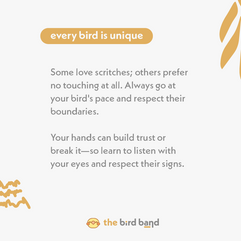Where to Pet Your Bird | The Right Way
- Ada Rocher
- Feb 13
- 2 min read
Petting isn’t a right; it’s a privilege!
When it comes to bonding with your bird, knowing how to pet them properly can strengthen your relationship and keep them emotionally healthy. Birds are sensitive creatures with unique boundaries, so let's dive into the do’s and don’ts of giving scritches.

Safe Zones
Stick to the head, neck, and cheeks. These are areas birds naturally preen for each other, known as mutual grooming zones. Petting here feels comforting and familiar, reinforcing trust and affection. Gentle strokes around these areas can be incredibly soothing for your bird.

No-Go Zones
Avoid the back, wings, and tail. Touching these areas can overstimulate your bird or trigger hormonal responses, leading to behavioral issues like aggression, territoriality, or even chronic egg-laying in females. Keeping your scritches to safe zones helps prevent unintentional stress or hormonal imbalances.

Reading Body Language
Birds communicate clearly if we know how to listen with our eyes. Signs your bird wants scritches include:
Leaning in or bowing their head
Fluffing up feathers around the head and neck
Gently beak-tapping or nudging your hand
Signs your bird is not interested include:
Pulling away or turning their head
Flattening feathers tightly against the body
Nipping or quick pecks at your hand
Always respect these signals to maintain trust.
Every Bird Is Unique
Some birds love scritches, while others prefer minimal or no touching. Their preferences can change with mood, season, or age. It’s essential to go at your bird’s pace, observing what makes them comfortable.
Tips for Trust-Building Scritches
Start Slow: Let your bird initiate contact. Don’t force interaction.
Use One Finger: A single finger feels less overwhelming than an entire hand.
Be Gentle: Light, soft touches mimic natural preening.
Time It Right: Avoid petting when your bird is eating, playing, or sleepy.
Final Thoughts
Your hands can either build trust or break it.
By learning to recognize your bird’s cues and respecting their boundaries, you create a safe, loving environment where they feel secure. Happy scritching!
















Comments